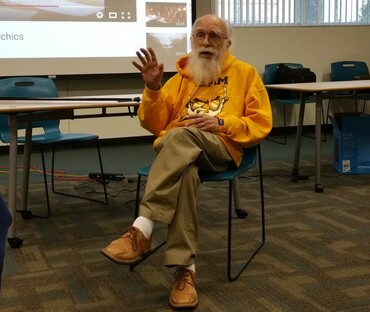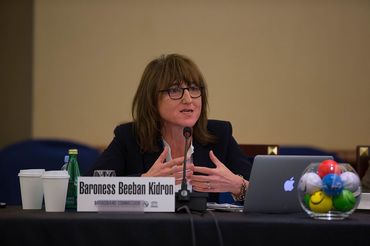Covid's children
 I wonder a lot about how the baby downstairs will develop differently because of his September 2020 birth date. In his first five months, the only humans who have been in close contact are his two parents, a smattering of doctors and nurses, and a stray neighbor who occasionally takes him for walks. Walks, I might add, in which he never gets out of his stroller but in which he exhibits real talent for staring contests (though less for intelligent conversation). His grandparents he only knows through video calls. His parents think he's grasped that they're real, though not present, people. But it's hard to be sure.
I wonder a lot about how the baby downstairs will develop differently because of his September 2020 birth date. In his first five months, the only humans who have been in close contact are his two parents, a smattering of doctors and nurses, and a stray neighbor who occasionally takes him for walks. Walks, I might add, in which he never gets out of his stroller but in which he exhibits real talent for staring contests (though less for intelligent conversation). His grandparents he only knows through video calls. His parents think he's grasped that they're real, though not present, people. But it's hard to be sure.
The effects of the pandemic are likely to be clear a lot sooner for the older children and young people whose lives and education have been disrupted over the past year. This week, as part of the LSE Post-Covid World Festival, Sonia Livingstone (for whose project I wrote some book reviews a few years ago) led a panel to discuss those effects.
Few researchers in the UK - Livingstone, along with Andy Phippen, is one of the exceptions, as is, less formally, filmmaker and House of Lords member Beeban Kidron, whose 2013 film InRealLife explores teens' use of the Internet - ever bother to consult children to find out what their online experiences and concerns really are. Instead, the agenda shaped by politicians and policy makers centers on adults' fears, particularly those that can be parlayed into electoral success. The same people who fret that social media is posing entirely new problems today's adults never encountered as children refuse to find out what those problems look like to the people actually experiencing them. Worse, the focus is narrow: protecting children from pornography, grooming, and radicalization is everywhere, but protecting them from data exploitation is barely discussed. In the UK, as Jen Persson, founder of DefendDigitlMe, keeps reminding us, collecting children's data is endemic in education.
This was why the panel was interesting: all four speakers are involved in projects aimed to understand and amplify children's and young people's own concerns. From that experience, all four - Konstantinos Papachristou, the youth lead for the #CovidUnder19 project, Maya Götz, who researches children, youth, and television, Patricio Cuevas-Parra, who is part of a survey of 10,000 children and young people, and Laurie Day - highlighted similar issues of lack of access and inequality - not just to the Internet but also to vaccines and good information.
In all countries, the shift to remote leaning has been abrupt, exposing infrastructure issues that were always urgent, but never quite urgent enough to fix. Götz noted that in some Asian countries and Chile she's seeing older technologies being pressed into service to remedy some of this - technologies like broadcast TV and radio; even in the UK, after the first lockdown showed how many low-income families could not afford sufficient data plans, the the BBC began broadcasting curriculum-based programming.
"Going back to normal," Day said, "needs a rethink of what support is needed." Yet for some students the move to online learning has been liberating, lightening social and academic pressures and giving space to think about their values and the opportunity to be creative. We don't hear so much about that; British media focus on depression and loss.
By the time the baby downstairs reaches school age, the pandemic will be over, but its footprint will be all over how his education proceeds.
Persson, who focuses on the state's use of data in education, says that one consequence of the pandemic is that Microsoft and Google have entrenched themselves much more deeply into the UK's education infrastructure.
"With or without covid, schools are dependent on them for their core infrastructure now, and that's through platforms joining up their core personal data about students and staff - email addresses, phone numbers, names, organizational data - and joining all that up," she says. Parents are encouraged to link to their children's accounts, and there is, for the children concerned, effectively, "no privacy". The software, she adds, was really designed for business and incompletely adapted for education. For example, while there are controls schools can use for privacy protection, the defaults, as always, are towards open sharing. In her own children's school, which has 2,000 students, the software was set up so every user could see everyone else's email address.
"It's a huge contrast to [the concern about] online harms, child safety, and the protection mantra that we have to watch everything because the world is so unsafe," she says. Partly, this is also a matter of perception: policy makers tend to focus on "stranger danger" and limiting online content rather than ID theft, privacy, and how all this collected data may be used in the future. The European Digital Rights Initiative (EDRi) highlights the similar thinking behind European Commission proposals to require the platforms to scan private communications as part of combating child sexual abuse online.
All this awaits the baby downstairs. The other day, an 18-month-old girl ran up to him, entranced. Her mother pulled her back before she could touch him or the toys tied to his stroller. For now, he, like other pandemic babies, is surrounded by an invisible barrier. We won't know for several decades what the long-term effect will be.
Illustrations: Illustrations: Sonia Livingstone's LSE panel.
Wendy M. Grossman is the 2013 winner of the Enigma Award. Her Web site has an extensive archive of her books, articles, and music, and an archive of earlier columns in this series. Stories about the border wars between cyberspace and real life are posted occasionally during the week at the net.wars Pinboard - or follow on Twitter.

